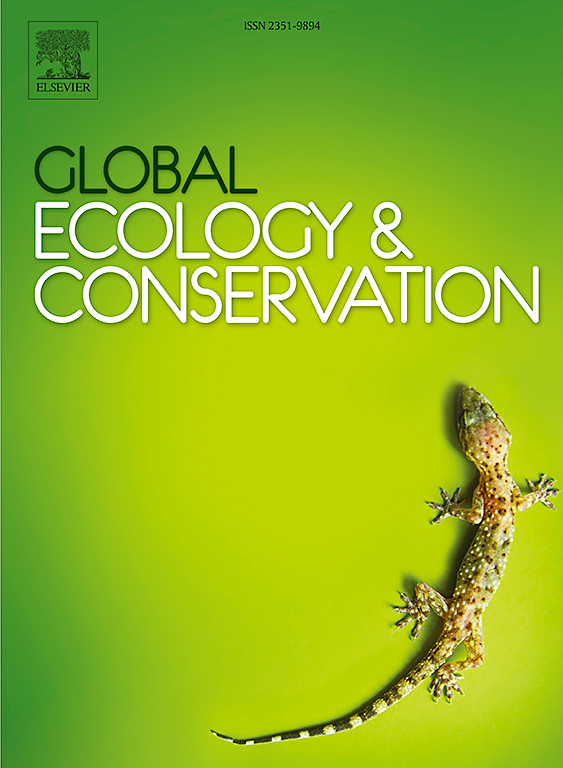Influence of native ungulate herbivory on riparian floral resources and native bee communities
IF 3.4
2区 环境科学与生态学
Q1 BIODIVERSITY CONSERVATION
引用次数: 0
Abstract
Bees are essential pollinators in many natural and agricultural systems and declines of some species are well-documented. Threats to bees include habitat loss and degradation and uncertainty remains about how management practices influence bee communities. Globally, ungulates are common in many systems and though numerous studies have examined livestock effects on bees, native ungulate effects on bees are poorly studied. In the western US, two native ungulates, deer (Odocoileus spp.) and elk (Cervus canadensis), are widespread and may occupy large annual home ranges. Public land managers are tasked with managing deer and elk habitat in ways compatible with other land uses, including as pollinator habitat. To address the question of how these large herbivores influence bee communities, we conducted a three-year manipulative study in a Pacific Northwest riparian system. Half of 12 sites were protected from native ungulate herbivory and half were unprotected. We measured bloom availability and diversity each year, and quantified herbivory pressure and sampled bees in the third year. We found fewer blooms of plant species preferred by elk, the dominant large herbivore in the system, in unprotected sites than protected sites in the second and third years, and that blooming plant composition differed between protected and unprotected sites. Bee species richness was lower in unprotected areas in July of the third year and evidence suggests that bees specializing on plants consumed by ungulates may be at particular risk. Our work illustrates the importance of considering dietary overlap when investigating effects of ungulates on bee communities.
原生有蹄类食草动物对河岸植物资源和原生蜜蜂群落的影响
蜜蜂是许多自然和农业系统中必不可少的传粉者,一些物种的减少有充分的记录。蜜蜂面临的威胁包括栖息地丧失和退化,管理措施如何影响蜜蜂群落仍不确定。在全球范围内,有蹄类动物在许多系统中都很常见,尽管有许多研究调查了牲畜对蜜蜂的影响,但对本地有蹄类动物对蜜蜂的影响的研究很少。在美国西部,两种本土有蹄类动物,鹿(鹿科)和麋鹿(鹿科)分布广泛,每年可能占据很大的活动范围。公共土地管理者的任务是以与其他土地用途兼容的方式管理鹿和麋鹿的栖息地,包括作为传粉媒介的栖息地。为了解决这些大型食草动物如何影响蜜蜂群落的问题,我们在太平洋西北河岸系统进行了为期三年的操纵研究。12个地点中有一半受到保护,不受本地有蹄类食草动物的侵害,一半不受保护。我们每年测量花的可用性和多样性,并在第三年量化草食压力和取样蜜蜂。结果表明,在第2年和第3年,受保护地的开花植物数量少于受保护地,且开花植物的组成在受保护地和受保护地之间存在差异。第三年7月,未受保护地区的蜜蜂物种丰富度较低,有证据表明,专门从事有蹄类食用植物的蜜蜂可能面临特别的风险。我们的工作说明了在研究有蹄类动物对蜂群的影响时考虑饮食重叠的重要性。
本文章由计算机程序翻译,如有差异,请以英文原文为准。
求助全文
约1分钟内获得全文
求助全文
来源期刊

Global Ecology and Conservation
Agricultural and Biological Sciences-Ecology, Evolution, Behavior and Systematics
CiteScore
8.10
自引率
5.00%
发文量
346
审稿时长
83 days
期刊介绍:
Global Ecology and Conservation is a peer-reviewed, open-access journal covering all sub-disciplines of ecological and conservation science: from theory to practice, from molecules to ecosystems, from regional to global. The fields covered include: organismal, population, community, and ecosystem ecology; physiological, evolutionary, and behavioral ecology; and conservation science.
 求助内容:
求助内容: 应助结果提醒方式:
应助结果提醒方式:


